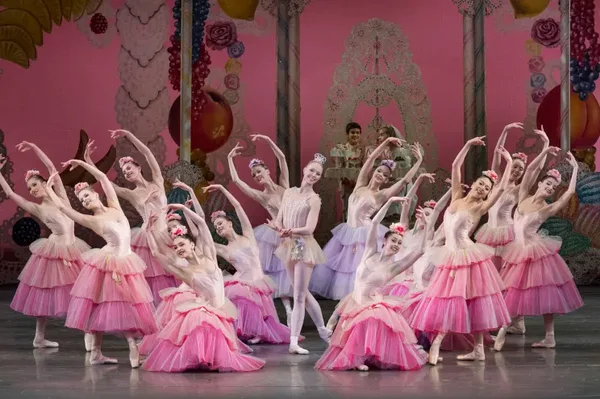Since we’re right in the midst of the holiday season, I thought that in the vein of the ongoing ONTD art series, the five ONTDers who actually read might be interested in learning about The Nutcracker. The Nutcracker ballet is now considered a holiday staple, but it’s a relatively new tradition. New York City Ballet is celebrating their 70th year performing The Nutcracker so they are doing a huge publicity push, which is what motivated me to write this post. Aspects of certain productions have not aged well, which has created some conflict in the dance world as some companies are pushing to remove offensive racial stereotypes while others are stubbornly sticking to their guns with the excuse of “but it’s always been this way!”
First up, some light and fluffy stuff:
NYCB principal dancer Unity Phelan on Kelly Clarkson
Nutcracker history: part 1 (the original stories and the first ballet performance)
The first production of The Nutcracker was intended to be a re-pairing of composer Pyotr Tchaikovsky and choreographer Marius Petipa, who had previously created a very popular and successful production of The Sleeping Beauty three years earlier. This new Nutcracker ballet was based on the 1844 short story The Nutcracker by Alexandre Dumas père, author of The Three Musketeers and The Count of Monte Cristo (as well as the father of Alexandre Dumas fils who wrote La Dame aux Camélias which was later adapted into Verdi’s opera La Traviata and the Greta Garbo film Camille). The Dumas short story was an adaptation of The Nutcracker and the Mouse King by German writer E.T.A. Hoffman in 1816.
The original Hoffman story is about a girl named Marie Stahlbaum who has a doll named Clara. Her godfather, a clockmaker and inventor named Drosselmeyer, brings a nutcracker as a gift to Marie’s family on Christmas Eve. He telle Marie a story about how nutcrackers were created (the short version is that his nephew was cursed). Marie says she would marry him even if he stayed an ugly nutcracker, which breaks the curse. The plot of the Dumas version is very similar to the original but the main character’s name is Marie Silberhaus.
Petipa knew what he wanted for The Nutcracker and gave Tchaikovsky very specific instructions for each composition of the ballet, often the exact tempo and number of bars he wanted. While choreographing The Nutcracker, Petipa became ill and his longtime assistant Lev Ivanov was brought in. It is still debated how much Petipa vs Ivanov contributed to the choreography of the original ballet, which was first performed in 1892 by the Imperial Russian Ballet (later known as the Kirov Ballet and then Mariisnky Ballet).
Unlike the previous Tchaikovsky/Petipa collaboration (Sleeping Beauty), The Nutcracker premiere was not successful and the show was criticized for numerous problems, including having too many children in the production. One notable change from the book is that the main character’s name was changed to Clara Silberhaus.
Nutcracker history: part 2 (leaving Russia/coming to America)
The Nutcracker first came to the United States (and the rest of the world) in 1911 when famed ballerina Anna Pavlova formed her own dance troupe and toured extensively. She adapted the end of Act I (In the Pine Forest and Waltz of the Snowflakes) into a ballet called Snowflakes. This was the first time that most people outside of Russia heard music from The Nutcracker. In addition, Pavlova’s production was the first time that the Pine Forest music was used as a pas de deux (a dance duet with a male and female dancer). Later productions took inspiration from this and used the Pine Forest music for Clara and the Nutcracker or the Snow Queen/Snow King.
In 1919, Alexander Gorsky staged a production of The Nutcracker based on the Petipa/Ivanov choreography. One of the major changes he made was casting adults in the roles of Clara and the Nutcracker/Prince and changing their friendship into a romance. He also eliminated the Sugar Plum Fairy, giving her dances to Clara.
The first full production of The Nutcracker outside of Russia was staged in England by Nicholas Sergeyev, a Russian dancer who fled Russia after the Bolshevik Revolution. He brought records of 20 ballets choreographed by Petipa and Ivanov with him in the hopes of preserving their work. In 1934 he staged The Nutcracker at the Royal Ballet (known as Vic-Wells at the time), using the original 1892 choreography of Petipa/Ivanov.
The same year, Vasili Vainonen staged a production of The Nutcracker which is still performed by Mariinsky Ballet (some of his choreography was also used in Mikhail Baryshnikov’s 1977 televised version of The Nutcracker). In Vainonen’s production, Clara’s name was changed to Masha. He also adapted Gorsky’s 1919 elimination of the Sugar Plum Fairy. His version ends with Masha realizing that it was all a dream.
The Nutcracker first came to the United States in 1940 when the Ballet Russe de Monte-Carlo tour performed an abridged version using Petipa/Ivanov’s choreography. Non-ballet audiences were also exposed to The Nutcracker the same year through Walt Disney’s Fantasia, which featured six songs from the ballet (Dance of the Sugar Plum Fairy, Chinese Tea, Arabian Coffee, Russian Trepak, Dance of the Reed Flutes, and Waltz of the Flowers).
Nutcracker history: part 3 (the origins of the American Christmas tradition)
The first American production of The Nutcracker took place in 1944. Willam Christensen, founder of the San Francisco Ballet, never intended for The Nutcracker to become a Christmas classic. His production was performed at Christmas because the ballet, the opera, and the symphony all shared the same venue which required the three organizations to juggle their schedules in order to accommodate all of their performances. The stage was available in December and Willam saw this as an opportunity to present an annual holiday ballet, but his intention was to have a different ballet each December.
He had previously choreographed excerpts of The Nutcracker in 1935. He later saw the Ballet Russe de Monte Carlo production when they performed in San Francisco. He pieced together a full length production by first gathering information from dancers who had performed in the 1919 Petipa-Ivanov production for the Mariinsky Theater. Some of the info he received was not complete, leaving him to create his own interpretation and choreography. George Balanchine told Willam about the character of Mother Ginger and the eight little girls hidden under Mother Ginger’s skirt, but not how the dance was staged or choreographed. When Alexandra Danilova began demonstrating some of Clara’s dance steps, Balanchine admonished her to let him create his own choreography.
A few years later, Christensen left SFB to create the country’s first university ballet department, eventually forming Ballet West (originally known as Utah Civic Ballet) with some of his University of Utah students, bringing his Nutcracker production with him. In 1954, Willam’s brother Lew choreographed an entirely new production of The Nutcracker, setting the show in the mid-nineteenth century and including Drosselmeyer’s nephew. He added a dancing bear (which was later adopted by the Boston Ballet production) and he replaced the gingerbread men with toy soldiers. The Spanish chocolate dance included a toro, and the Russian dance became the ribbon candy dance with a soloist (male or female depending on the performance) performing with ribbons attached to sticks.
In 1954, George Balanchine staged The Nutcracker for New York City Ballet. Balanchine had performed in The Nutcracker when he was a young dancer in Russia. He restored the original music and reconstructed some of the original choreography, but he also made several changes. He added a piece of music originally written for Sleeping Beauty, he moved the Sugar Plum Fairy’s solo to earlier in Act 2, and he cut her Cavalier’s tarantella. The original production had eighteen male-female couples perform the Waltz of the Flowers, but Balanchine changed this to fourteen female dancers and a soloist role (Dew Drop). In a nod to the original Hoffman story, he changed Clara’s name back to Marie Stahlbaum and included Drosselmeyer’s nephew.
Although Unity Phelan told Kelly Clarkson that the production hasn’t changed in 70 years, that isn’t true. Balanchine continued to make changes to the show over the years. His original version of the Arabian coffee dance featured Arthur Mitchell (who went on to found Dance Theatre of Harlem) smoking a hookah pipe while surrounded by children dressed in parrot costumes. Balanchine’s production didn’t make Arabian coffee into a showcase for a female dancer (as we know it now) until 1964.
Nutcracker history, part 4: racism in The Nutcracker

Nutcracker yellowface
One of the things that The Nutcracker is known for is the dances in the Land of Sweets in the second act like Spanish chocolate and the Russian trepak. But the Chinese tea dance has become notorious for its blatant racism. Dancers were often put in literal yellow makeup, had slanted eyes drawn with eyeliner, given long black queues, (ethnically incorrect) geisha wigs, plastic buck teeth, and/or stereotypical Fu Manchu facial hair. The choreography consisted of shuffling feet, pointed fingers, and repeated bowing. In most dance companies, one of two things happened during Nutcracker casting: either the only Asian dancers in the company were cast in Chinese tea year after year or white dancers were cast and put in full yellowface with slanted eyes and pointy straw hats.







